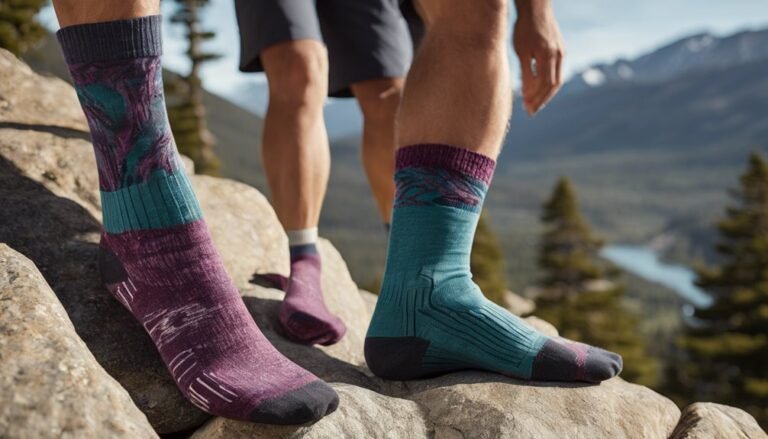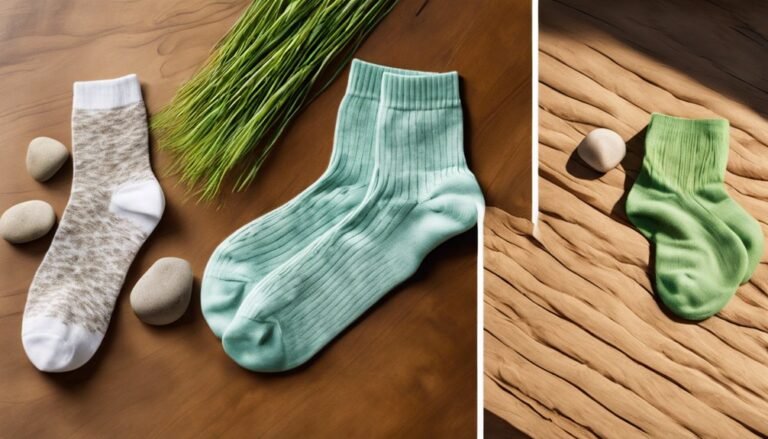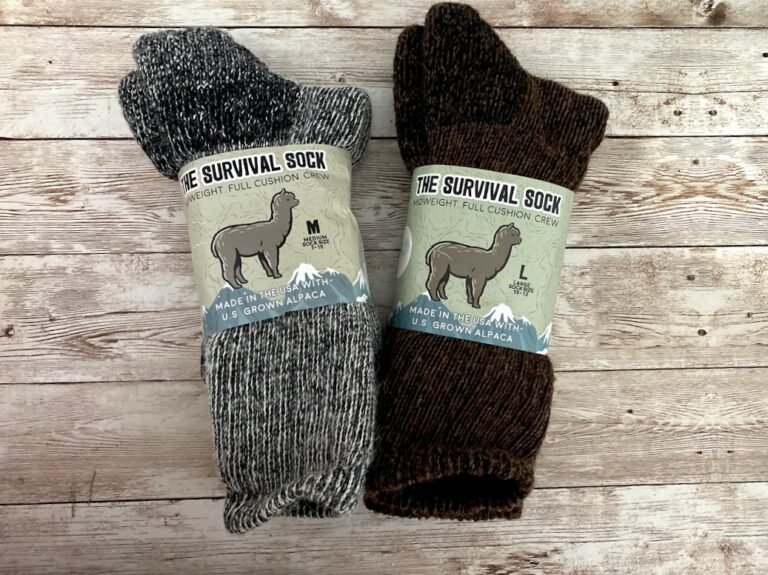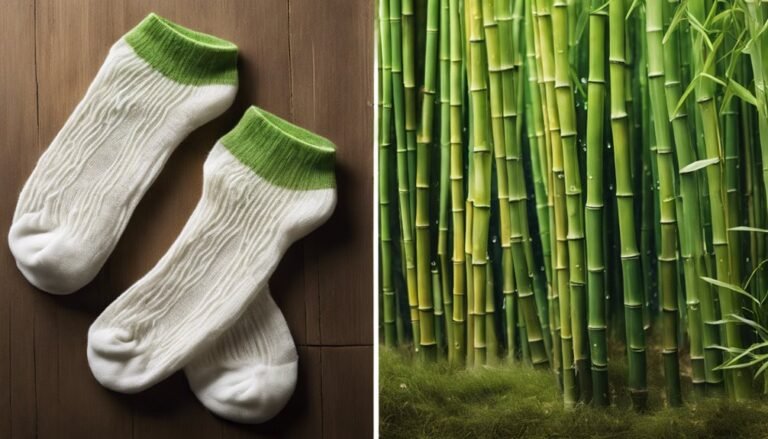Alpaca vs. Yak Wool Socks: Which Is Warmer?
When comparing the warmth of alpaca and yak wool socks, consider their thermal properties. Yak wool excels in extreme cold conditions, thanks to its superior insulation capabilities. Alpaca wool, while also warm, provides excellent temperature regulation and lightweight comfort but may not retain heat as effectively as yak. Ultimately, the choice depends on your specific needs for warmth and activity level. If you're curious about how these materials stack up in other factors, keep exploring the details.
Overview of Alpaca Wool

Alpaca wool, renowned for its exceptional qualities, offers a unique alternative to more common fibers. When exploring the various alpaca breeds, such as Huacaya and Suri, you'll notice distinct fiber characteristics that set them apart. Huacaya fibers are fluffy and crimped, providing excellent insulation, while Suri fibers are silky and lustrous, offering a unique drape. Both types are lightweight yet incredibly warm, making them ideal for socks. Additionally, alpaca wool is hypoallergenic, as it contains no lanolin, and is more resistant to water and dirt than sheep wool. This makes it not only comfortable but also practical. Understanding these attributes allows you to appreciate the versatility and appeal of alpaca wool in your quest for freedom in personal style.
Overview of Yak Wool
Yak wool, often celebrated for its warmth and durability, is harvested from the undercoat of the Tibetan yak. This unique fiber offers several yak wool benefits, including breathability and moisture-wicking properties. Sourcing yak wool involves semi-nomadic herding practices, ensuring sustainable and ethical harvesting.
| Yak Wool Benefits | Yak Wool Sourcing |
|---|---|
| Exceptional warmth | Harvested from Tibetan yaks |
| Moisture-wicking | Sustainable herding practices |
| Lightweight and strong | Ethical treatment of animals |
With its natural insulation and resilience, yak wool is an excellent choice for those seeking comfort and freedom in their outdoor adventures. By understanding its sourcing and benefits, you can make informed decisions about your next pair of warm socks.
Thermal Properties of Alpaca Wool
When considering thermal properties, alpaca wool stands out due to its remarkable ability to regulate temperature. It offers excellent alpaca insulation, trapping heat effectively while remaining lightweight. This means you can stay warm without feeling weighed down. Additionally, alpaca wool boasts impressive alpaca breathability, allowing moisture to escape, which helps prevent overheating. This dual capability makes it suitable for a variety of temperatures, keeping your feet comfortable in both cold and mild conditions. The unique structure of alpaca fibers contributes to these properties, ensuring they maintain their thermal advantages over time. When you choose alpaca wool socks, you're not just selecting warmth; you're opting for a balance of insulation and breathability that many other materials can't match.
Thermal Properties of Yak Wool

Both alpaca and yak wool offer impressive thermal properties, though they achieve their insulation through different mechanisms. Yak wool insulation is renowned for its ability to retain heat while remaining lightweight. This is largely due to yak fiber characteristics, which include a unique hollow structure that traps air, enhancing thermal regulation. The fibers are also coarser than alpaca, providing a denser layer of warmth. Additionally, yak wool has a natural moisture-wicking ability, keeping your feet dry and comfortable in cold conditions. When choosing between these two options, consider the specific thermal needs you have; yak wool can offer superior insulation for extreme cold, making it a solid choice for adventurous outdoor activities.
Softness and Comfort Comparison
While many factors influence the overall comfort of socks, the softness of the fibers plays an essential role in your experience. Alpaca wool is known for its impressive softness levels, often feeling luxurious against your skin. In contrast, yak wool, while still soft, may not provide the same buttery feel, making it slightly less comfortable for some wearers.
When evaluating comfort factors, consider how the fiber's texture interacts with your skin, especially if you're prone to irritation. Alpaca's finer, smoother fibers tend to minimize chafing, enhancing comfort during prolonged wear. Conversely, yak wool's coarser texture might lead to a slightly less pleasant experience. Ultimately, the choice between the two comes down to personal preference regarding softness and comfort.
Durability and Longevity
Although the softness of a sock can greatly enhance comfort, the durability and longevity of the materials are equally important factors to keep in mind. When comparing alpaca and yak wool socks, it is crucial to evaluate their resistance to wear and tear. Yak wool tends to be denser and more robust, often lasting longer under heavy use. Alpaca wool, while softer, may show signs of wear sooner, especially if not properly cared for. To extend the life of either type, follow these maintenance tips: wash in cold water, avoid harsh detergents, and air dry. By prioritizing durability alongside comfort, you can enjoy your socks for many seasons, ensuring they remain a trusted part of your wardrobe.
Moisture-Wicking Abilities
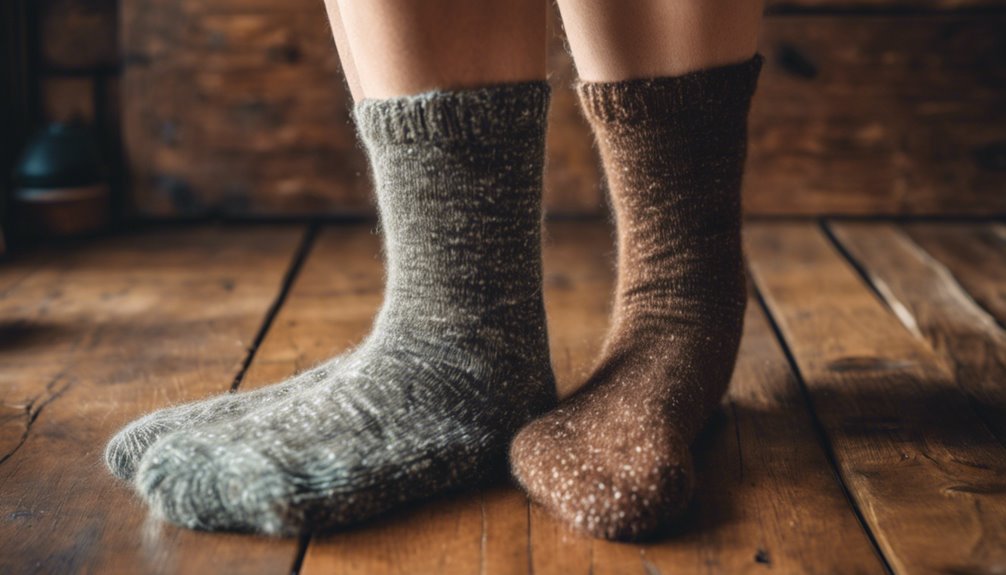
When it comes to moisture-wicking abilities, the performance of the material can greatly impact your overall comfort. Alpaca wool tends to have lower moisture retention compared to yak wool, allowing for better breathability factors. This means that when you're active, your feet are less likely to feel damp and uncomfortable. Yak wool, while still effective, may retain a bit more moisture, potentially leading to a heavier feeling if you're in particularly wet conditions. However, both materials offer excellent insulation properties. If you're looking for a sock that keeps your feet dry and comfortable during long hikes or chilly days, consider how each material's moisture-wicking abilities align with your specific needs and activities.
Environmental Impact of Production
When comparing alpaca and yak wool socks, it's important to take into account the environmental impact of their production. You'll want to evaluate the farming practices that each relies on, as well as their land use efficiency and overall carbon footprint. Understanding these factors can help you make a more informed decision about which material aligns with your sustainability values.
Farming Practices Comparison
As you compare alpaca and yak wool socks, it is essential to evaluate the environmental impact of their respective farming practices. Alpaca farming often emphasizes sustainable farming techniques, such as rotational grazing and minimal use of harmful chemicals. These practices promote soil health and biodiversity while ensuring animal welfare, as alpacas are generally raised in lower-density herds, reducing stress on the animals.
In contrast, yak farming, particularly in the Himalayan region, sometimes faces challenges related to overgrazing and habitat degradation. However, many yak farmers are adopting sustainable practices to mitigate these issues and enhance animal welfare. Both farming methods have their strengths, but the commitment to sustainable practices ultimately influences the overall environmental footprint of the wool production process.
Land Use Efficiency
While both alpaca and yak wool production requires land, the efficiency of land use varies considerably between the two. Alpacas tend to thrive in more diverse environments, allowing for better land use practices. In contrast, yaks, often raised in harsher climates, may require larger expanses of land for sustainable farming. Here are some key points regarding their land use efficiency:
- Alpacas: More adaptable to various terrains, leading to better utilization of limited land.
- Yaks: Require extensive grazing areas to support their larger body size and dietary needs.
- Sustainable Practices: Both animals can contribute to land restoration, but alpacas often show quicker regeneration of pastures.
Understanding these differences can help you make informed decisions about the environmental impact of wool production.
Carbon Footprint Analysis
The environmental impact of wool production extends beyond land use to include the carbon footprint associated with raising alpacas and yaks. When considering sustainable sourcing, both options have unique factors that affect their carbon emissions.
| Animal | Average Carbon Footprint (kg CO2e/year) | Carbon Footprint Reduction Potential |
|---|---|---|
| Alpaca | 50 | High (due to low feed requirements) |
| Yak | 70 | Moderate (pasture-based grazing) |
Alpacas generally have a lower carbon footprint due to their efficient feed conversion and lower methane production. In contrast, yaks contribute more emissions but can still achieve carbon footprint reduction through sustainable practices. Consequently, choosing between alpaca and yak wool socks involves considering both warmth and environmental impact.
Price Comparison
When comparing the prices of alpaca and yak wool socks, you'll find a noticeable difference that can influence your purchasing decision. A thorough cost analysis reveals that alpaca socks typically come at a higher price point due to their luxurious feel and rarity. In contrast, yak wool socks are often more affordable, making them an attractive option for budget-conscious shoppers.
Here's a quick price comparison overview:
- Alpaca Socks: Generally range from $20 to $50 per pair.
- Yak Wool Socks: Usually priced between $15 and $35 per pair.
- Quality Consideration: Both types offer warmth, but the price reflects their sourcing and production.
Ultimately, your choice may hinge on how much you're willing to invest for comfort and quality.
Which Socks Are Best for Different Activities?
Which type of sock suits your activities best? For hiking, you'll want socks that provide cushioning and moisture-wicking properties. Look for hiking socks made from alpaca wool; they offer excellent insulation while remaining lightweight. On the other hand, if you're into winter sports, opt for yak wool socks. Yak wool excels in maintaining warmth even in extreme cold, making it ideal for skiing or snowboarding. The thicker fabric provides added protection against cold and dampness. Consider your activity's demands: hiking requires flexibility and breathability, while winter sports necessitate warmth and durability. Choosing the right sock can greatly enhance your comfort and performance in any outdoor adventure.
Frequently Asked Questions
Can Alpaca or Yak Wool Be Machine Washed?
When considering care instructions, you shouldn't machine wash alpaca or yak wool. Instead, gentle hand washing is recommended to preserve fibers. Using appropriate washing methods guarantees your socks maintain their softness and durability over time.
Are There Any Allergies Associated With Alpaca or Yak Wool?
While wool's warmth beckons, some folks may experience allergy symptoms or wool sensitivity. Both alpaca and yak wool are generally hypoallergenic, but individual reactions can vary, so it's wise to test before full use.
How Do Alpaca and Yak Wool Socks Compare in Breathability?
In the breathability comparison, alpaca fibers have a smoother structure, allowing better airflow. Yak wool, while dense, offers insulation but less breathability. You'll find alpaca socks generally more comfortable for prolonged wear in varying conditions.
Do Alpaca or Yak Wool Socks Come in Different Thicknesses?
Both alpaca and yak wool socks come in various thicknesses, allowing for tailored warmth and comfort. Notably, thicker socks can enhance warmth by up to 30%, making sock thickness a vital factor in warmth comparison.
What Are the Best Brands for Alpaca and Yak Wool Socks?
When choosing socks, consider top alpaca brands like Peruvian Link and Alpaca Warehouse, while best yak brands include Yaktrax and Yakski. Each offers unique qualities, ensuring you find the perfect fit for your needs.


